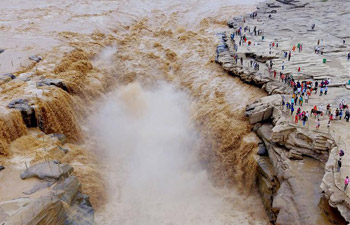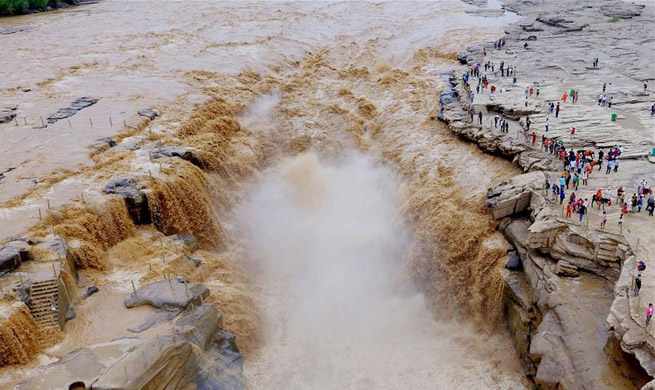TOKYO, Aug. 31 (Xinhua) -- Japan's Ministry of Defense announced on Thursday a record-high budget request for the fiscal year 2018, which, if approved, would mark the sixth annual increase since Prime Minister Shinzo Abe retook office in 2012.
The defense ministry's budget request, up by 2.5 percent from this year's initial budget, totals 5.26 trillion yen (47.8 billion U.S. dollars) for the fiscal year starting from April, 2018.
The budget request was compiled by setting the dollar's exchange rate at 110 yen for fiscal 2018, according to the ministry.
Part of the money would be used to introduce a new missile shield system, possibly the land-based Aegis Ashore, but the amount was unspecified as it still needs to be hammered out with the United States, said the ministry.
Japan has so far taken steps to counter any potential launches of ballistic missiles by deploying high-tech Aegis advanced radar-equipped destroyers which are tasked with stopping missiles in the outer atmosphere, and ground-based Patriot Advanced Capability-3 interceptors which will counter the attack at lower altitudes.
The Aegis Ashore system is a land-based version of the Aegis advanced radar system, and with potential to be permanently installed, it is expected to reduce the workload of the Japanese Self-Defense Forces members in missile intercept operations.
Each Aegis Ashore unit costs around 80 billion yen, and Japan would need two units to cover the whole landmass, experts here have said.
To improve the efficiency of current systems, the defense ministry also seeks 47.2 billion yen to acquire SM-3 Block IIA intercept missiles, which are designed to hit warheads in space before they plunge to their targets, and 20.5 billion yen for PAC-3 MSE missiles, which could double the range of defense compared to current PAC-3 batteries deployed nationwide.
To "enhance the ability to protect isolated islands," the ministry plans to acquire two destroyers that can remove sea mines, six F-35A stealth fighters, and four Osprey tilt-rotor transport aircraft.
It also requests 55.2 billion yen for the maintenance of facilities for Self-Defense Forces units stationed on the southwestern islands of Okinawa, and 10 billion yen for developing technologies to create high-speed glide bombs for operations to "retake invaded remote islands."
The ministry is also eyeing allocating 11 billion yen for a research funding program called National Security Technology Research Promotion, the same amount as fiscal 2017, but surging 37 times compared to the 300 million yen in fiscal 2015 when the program was set up.
The program has been widely opposed by Japanese scholars and researchers for fear of government intervention of research and further deviation from Japan's pacifist Constitution which specifies that Japan renounces war as a sovereign right of the nation and will not maintain land, sea, and air forces, as well as other war potential.
The budget request was also put forward amid public concerns over Japan's precarious fiscal condition under the current sluggish economy and with consumption tax hike delayed for multiple times.
The Japanese government is burdened with arrears that stand as the highest in the industrialized world, amounting to more than twice the size of Japan's economy.
The budget requests of various ministries will be screened and trimmed by the financial ministry and a state budget for fiscal 2018 will be compiled by the end of this year.

















